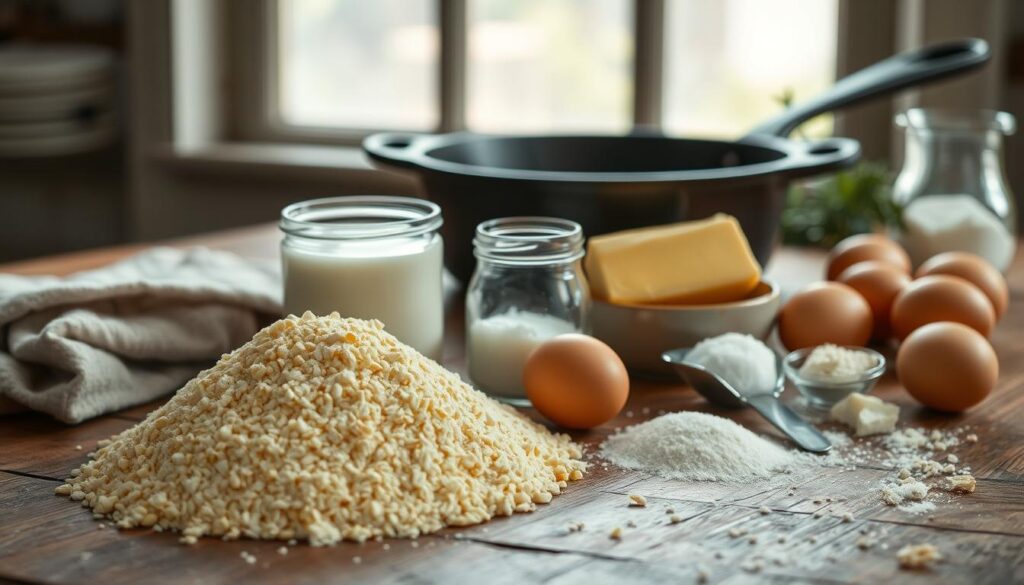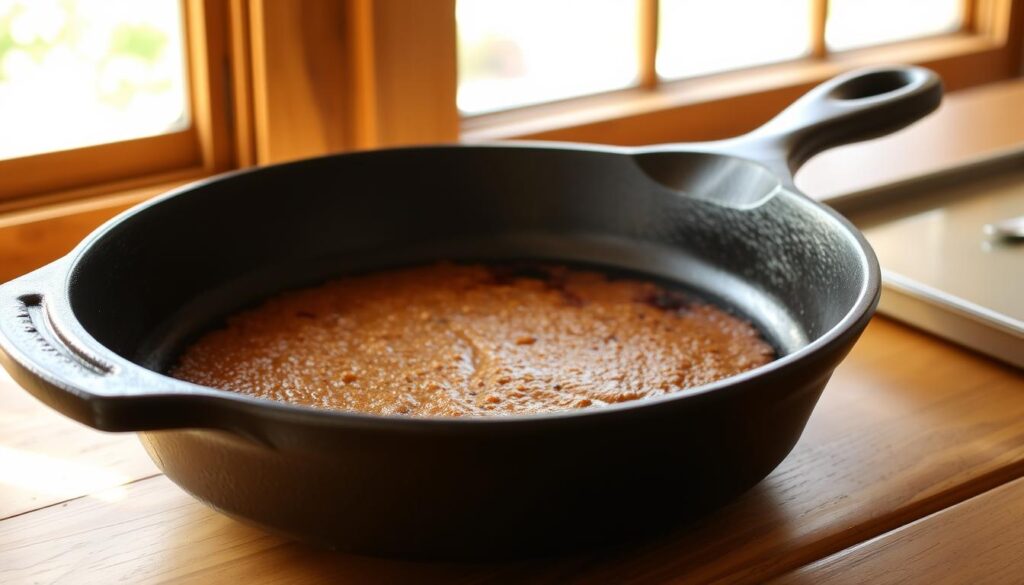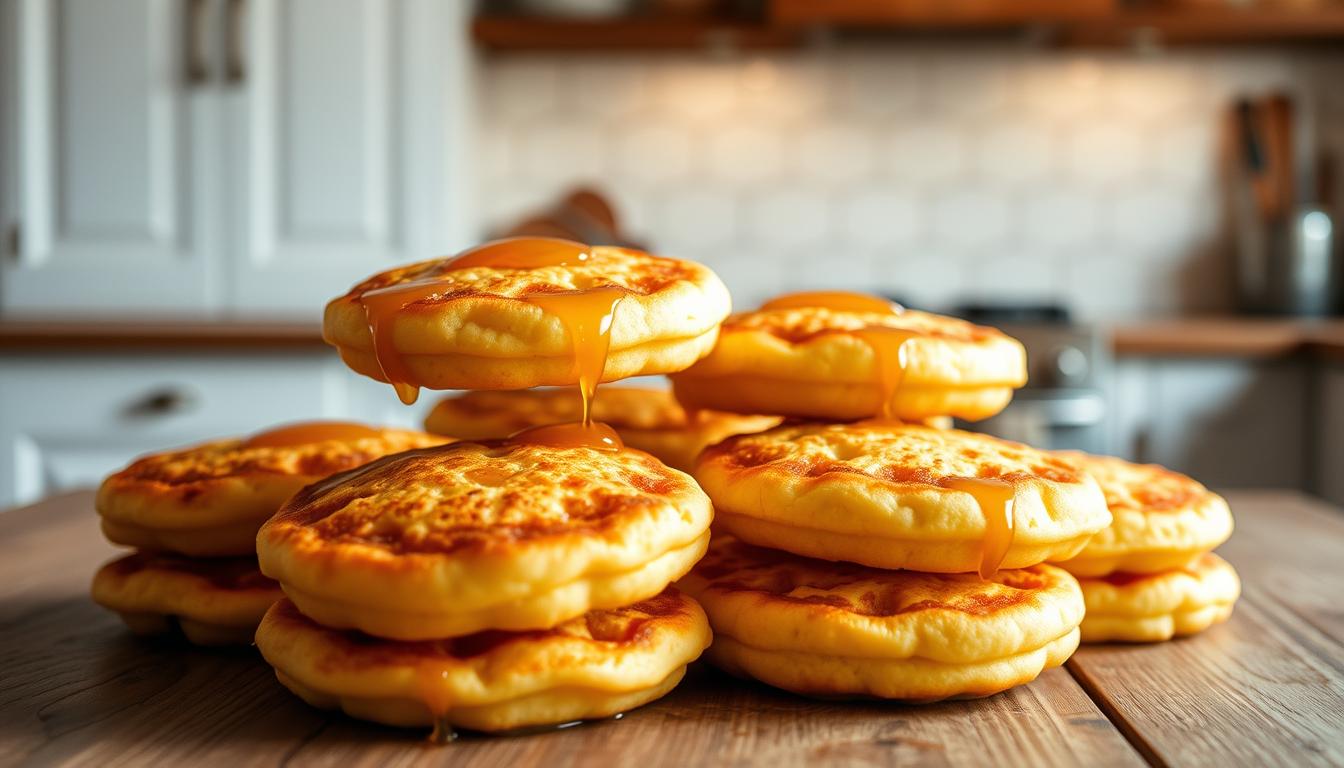Step-by-step hoe cake recipe
hoe cake recipe :
Imagine sitting down to a warm, comforting meal that instantly transports you to the heart of the South. For many, that meal is a traditional Southern hoe cake, a dish steeped in history and rich in flavor. Despite its simplicity, this classic has a way of taking center stage at any dinner table.
You might be surprised to learn that this beloved dish can be made with either cornmeal or flour, depending on regional preferences. What’s more, it’s incredibly versatile – perfect for breakfast, as a side dish, or even as a dessert. This traditional recipe has been passed down through generations, representing authentic Southern cooking at its finest.
With this step-by-step guide, you’ll be able to recreate this Southern classic in the comfort of your own home. Get ready to experience the exceptional flavor and texture that makes hoe cakes a timeless favorite.
What Are Hoe Cakes?
The simplicity and versatility of hoe cakes make them a beloved Southern classic. Hoe cakes are essentially a traditional Southern bread that comes in two main variations: cornmeal-based and flour-based.
Different Variations of Hoe Cakes
While cornmeal hoe cakes resemble flat pancakes and are made with cornmeal and often buttermilk, flour-based hoe cakes are more akin to biscuits but with a lighter and fluffier texture. Regional differences across the South have led to various interpretations of this classic food.
- Cornmeal-based hoe cakes are dense and have a distinct corn flavor.
- Flour-based hoe cakes are lighter and often have a crispy exterior.
Why You’ll Love This Southern Classic
Hoe cakes have remained popular throughout generations due to their simplicity and versatility. You can enjoy them with sweet toppings like maple syrup or with savory accompaniments like gravy. The use of buttermilk in both variations adds tanginess and helps with leavening, making them a delightful treat.
The appeal of southern hoe cakes lies in their comforting nature and the fact that they can be served in various ways, making them suitable for both breakfast and dinner.
tag.
6. To create a keyword placement matrix, I will ensure that the density of keywords does not exceed 2%. Given that the total word count for Section 3 is approximately 130 words for the H2 section, the maximum keyword repeats should be around 2-3 times.
7. I will break down paragraphs to ensure they are concise and follow the Flesch Reading Ease and Flesch-Kincaid Grade level guidelines.
8. The recommended text size for Section 3 is 130 words for the H2 section.
8.1. I will take into account the H2 and H3 headings specified for Section 3.
Here’s the content for Section 3:
The History Behind Hoe Cake Recipe
The origins of hoe cakes are rooted in the resourcefulness of early American cooks who utilized simple ingredients and cooking methods. Hoe cakes have their roots in the cooking techniques of early American settlers and indigenous peoples.
Origin of the Name
The term “hoe cake” is believed to have originated from cooking the batter on the flat blade of a hoe over an open fire. However, there are alternative explanations, including a connection to griddle cooking, as the term “hoe” was sometimes used to refer to cooking utensils similar to a griddle.
Cultural Significance in Southern Cuisine
Hoe cakes became a staple in Southern cuisine due to the availability of cornmeal and simple cooking methods. Enslaved people played a significant role in adapting and developing hoe cake recipes, contributing to the rich culinary heritage of the South.
| Aspect | Description |
|---|---|
| Historical Origins | Early American settlers and indigenous cooking techniques |
| Cooking Method | Cooking on a hoe or griddle over an open fire |
| Cultural Impact | Staple in Southern cuisine, influenced by enslaved people’s adaptations |
Ingredients You’ll Need
Hoe cakes require a straightforward list of ingredients, which we’ll outline below. The ingredients vary slightly depending on whether you’re making the traditional flour-based version or the cornmeal-based alternative.
Traditional Flour-Based Version
For the traditional flour-based hoe cakes, you’ll need self-rising flour, vegetable shortening, and whole milk. If you don’t have self-rising flour, you can make it by combining 1 cup of all-purpose flour with 1 1/2 teaspoons of baking powder and 1/4 teaspoon of salt.
Cornmeal-Based Alternative
The cornmeal-based version requires 1.5 cups of white cornmeal, 1/2 cup of all-purpose flour, 1 teaspoon of baking powder, 1/2 tablespoon of sea salt, 1 tablespoon of sugar, 1 egg, 1 cup of buttermilk, 3/4 cup of hot water, and 2 tablespoons of melted butter.
| Ingredient | Flour-Based Version | Cornmeal-Based Version |
|---|---|---|
| Flour | 1 cup self-rising | 1/2 cup all-purpose |
| Cornmeal | – | 1.5 cups white |
| Buttermilk | 1 cup whole milk | 1 cup |
| Sugar | – | 1 tablespoon |

The use of white cornmeal is preferred for an authentic Southern flavor, though yellow cornmeal can be used as a substitute. Buttermilk is crucial for the moisture and tenderness of the hoe cakes; you can make a substitute by mixing 1 cup of milk with 1 tablespoon of white vinegar or lemon juice.
Essential Kitchen Tools
Gathering the right kitchen tools is the first step to making delicious hoe cakes. To achieve the perfect crispy exterior and fluffy interior, you’ll need to have the right equipment.
Cast Iron Skillet Options
A well-seasoned cast iron skillet is the traditional and preferred cooking vessel for authentic hoe cakes. The heat retention properties of cast iron contribute to the perfect crispy exterior. You can choose from various sizes and types of cast iron skillets, including modern pre-seasoned options.
Other Helpful Equipment
In addition to a cast iron skillet, you’ll need a mixing bowl to prepare the batter, measuring cups and spoons for accurate measurements, and a spatula for flipping the hoe cakes. If you don’t own a cast iron skillet, a heavy-bottomed skillet or griddle can be used as an alternative.
| Tool | Purpose |
|---|---|
| Cast Iron Skillet | Cooking Hoe Cakes |
| Mixing Bowl | Preparing Batter |
| Measuring Cups/Spoons | Accurate Measurements |
| Spatula | Flipping Hoe Cakes |

Step-By-Step Hoe Cake Recipe
Our step-by-step hoe cake recipe is designed to help you create mouth-watering hoe cakes that are sure to become a family favorite. To start, you’ll need to prepare the batter, heat the oil or bacon grease, and then cook the hoe cakes to perfection.
Preparing the Batter
To prepare the batter, combine two cups self-rising flour and 1/2 cup of shortening in a large bowl. Cut it in with a fork until the mixture resembles coarse crumbs. Then, add one cup of milk to your dry ingredients and stir with a spoon until all the ingredients are wet. For the cornmeal version, whisk together white cornmeal, all-purpose flour, baking powder, sea salt, and white sugar. Add the egg, buttermilk, water, and melted butter to the dry ingredients and mix until just combined.
Heating the Oil or Bacon Grease
Preheat your oven to 425 degrees if you’re baking, or heat a griddle or large skillet over medium heat if you’re cooking on the stovetop. For oven-baked hoe cakes, pour a thin layer of vegetable oil into the bottom of a cake pan. For stovetop cooking, add enough oil to coat the surface of the griddle or skillet.
Cooking Techniques for Perfect Results
For oven-baked hoe cakes, pour the batter into the hot pan and bake at 425 degrees until browned on top, or about 15-20 minutes. For stovetop hoe cakes, spoon the batter onto the griddle to form small cakes. Cook until edges set and bubbles form (about 2-3 minutes), then flip and cook until golden brown. The key to perfect hoe cakes is following these instructions carefully and not overmixing the batter.
| Cooking Method | Cooking Time | Visual Cue |
|---|---|---|
| Oven-Baked | 15-20 minutes | Browned on top |
| Stovetop | 2-3 minutes per side | Golden brown |
Serving Suggestions and Pairings
The beauty of hoe cakes lies in their adaptability, making them a perfect side dish for various meals and occasions. You can enjoy them with a range of toppings and accompaniments, from sweet treats to savory delights.
Sweet Toppings
For a traditional touch, top your hoe cakes with maple syrup, honey, or apple butter. These sweet toppings complement the cake’s flavor and add a delightful twist. You can also experiment with modern combinations like fruit compotes or whipped butter with cinnamon sugar.
Savory Accompaniments
Hoe cakes can also be served as a savory side dish, pairing well with classic Southern main courses like fried chicken or pork chops. To enhance the flavor, consider adding jalapenos, grated cheese, or chopped bacon to the batter.
Complete Meal Ideas
For a complete meal, serve hoe cakes alongside eggs and breakfast meats for a hearty breakfast. Alternatively, pair them with North Alabama-style pulled BBQ chicken or chicken and gravy for a satisfying dinner.
| Meal Type | Hoe Cake Pairing |
|---|---|
| Breakfast | Eggs, bacon, and maple syrup |
| Lunch/Dinner | Fried chicken, pork chops, or BBQ |
| Savory Side | Jalapenos, cheese, or bacon bits |
Conclusion
With its rich history and versatility, the hoe cake recipe is a culinary treasure worth preserving. You’ve learned about the two main variations – flour-based and cornmeal-based hoe cakes – and how to store leftovers in the fridge for up to four days or freeze them for up to three months.
To reheat, simply place slices on a baking sheet in a 350-degree oven for five to 10 minutes. Experiment with your own hoe cake variations, connecting with Southern culinary traditions while making it your own. Share your experiences and family recipes to keep this tradition alive.

